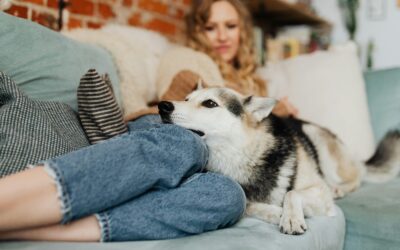Although people refer to working through separation anxiety as “separation anxiety training”, it absolutely does not fall into the remit of “training”. When a dog displays anxiety about being home alone, that dog is having an emotional response to being alone – it is a phobia. That dog is truly terrified about being alone, therefore it is not the same as teaching a dog a new trick, or teaching them to lie down.
Because separation anxiety is that emotional response, in order to help your dog overcome it we must aim to change your dog’s emotions surrounding being alone. We want them to go from feeling terrified, to feeling relaxed and comfortable, and that takes time. As with humans who suffer anxiety and phobias, there is no quick fix, and every single dog (as with humans) is different – in the presentation of the behaviours, the level of anxiety, background, home environment, other potentially contributing factors etc Therefore it is impossible to predict how long the journey will take.
I will say, however, that it is not generally a quick process – again, because changing emotions, changing the way your dog feels, changing the association surrounding being alone, all take time.

There are also various external and internal factors and stressors that can affect how your dog progresses.
What factors can affect progress?
- Medical factors
Dogs show discomfort and pain very differently to how we would expect them to do so. If i had a pound coin for every dog who I worked with who ended up having a previously undiagnosed medical condition (often GI or musculoskeletal), I would have an overflowing piggy bank thats for sure! There is a huge correlation between pain and behaviour, with D. MIlls et al (2020) stating that over 80% of dogs seen for behaviour concerns had pain contributing to their behaviour. This is why I conduct a full Dynamic Dog assessment with ALL clients I work with – it is part of my normal assessment process. This is where I assess all dogs, via photos and videos, for any potential signs of pain/discomfort so I can convey my observations to the referring vet to assist them. If a dog is in discomfort, their emotional resilience and tolerance will reduce, and it will hugely impact their ability to learn to feel safe home alone. Remember that dogs need to feel comfortable and safe in order to learn. - Other external stressors
If there are other areas of your dog’s life causing them anxiety and stress, it is likely to negatively impact their ability to progress on a separation anxiety protocol, thereby meaning it will take more time or you will experience more inconsistencies and regressions. As mentioned abo0ve, dogs need to feel safe to learn, therefore we need to ensure we minimise (as much as possible) stressors in their day to day life. For example, are you walking them in a busy park, when they are also nervous around other dogs, and every day other dogs run over off lead to your dog, causing constant stress and anxiety? Or is your dog looking out the window throughout the day and barking at every single passer by? If so, this will result in increased cortisol and an inability to progress forward, and I would consider walking them at a quieter place, or a quieter time of day, and putting window film at the window to prevent them rehearsing that behaviour and keep them calmer. - Are you tracking data?
If not, you are likely to be missing any potential patterns, and not noticing variables that may be impacting how well your dog can cope (eg time of day, which humans are involved, how much exercise your dog has had etc). Tracking data is vital and if youre missing these patterns, the progress will be slower and more inconsistent but you wont know why - Not letting your dog set the pace
Everyone has been there! Your dog is comfortable for 10 seconds now, so you decide to push and leave for 1 minute, or 5 minutes, and then your dog falls apart again. It is SO important to remember that it is not us that sets how fast or slow the process goes – it is your dog. We HAVE to go with what they are telling us, and if at 12 seconds they show signs that they are uncomfortable, or becoming anxious, we need to bring things right down so that we are coming back when they are comfortable. - Working on it yourself Vs with a qualified behaviourist who specialises in separation anxiety
Now you may say, well I am bound to say this, and yes possibly I am! But….there are reasons WHY i say this! I have lost track of the number of people I have worked with who have tried to work through their dog’s separation anxiety themselves before working with me. Some of them have achieved some success but then it has taken a nose dive, some have not been able to achieve any success, and some have found it so inconsistent that they are totally confused. And I totally get it! Working through separation anxiety is tough. But specialists like myself who are qualified in dog behaviour, specialise in separation anxiety AND are qualified to assess dogs for signs of pain or discomfort that commonly go missed (and yes all dogs I work with have been checked by a vet but showed no traditional pain responses in the clinic setting, which is common) are able to look all aspects of your dog, and your life with your dog, to assess any other areas of their life that might be impacting progression or causing those inconsistencies. Additionally, all the advice on line is generic – and there is no “one size fits all” approach with dog behaviour.
The destination is worth the journey
So I haven’t actually answered how long the process can take have i! As mentioned, its impossible to put a time scale on it. But…. what I WILL say, is to always think in terms of months. Definitely not weeks. How many months that could be will be determined by your dog and your dog alone. Its not uncommon for it to take a year, or more, and while it can be very easy to give up, it is also very important to remember that while it is a long, windy, bumpy road, the destination is very very worth the journey! The quicker you get started the quicker you will get your life back!

Angela Doyle – Polite Paws
2025
If you would like help with working through your dog’s separation anxiety please complete the form on the page below and I will be in touch to arrange a free initial phone call:



